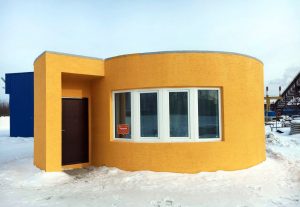Mar 24 2017
3D Printed Houses
 Here is a light and fun item for a Friday – we are making progress in the technology for 3D printing houses. Business Insider did a review of a San Francisco startup, Apis Cor, that says it built a 400 sq ft. house in 24 hours with $10,134 worth of materials. That is pretty impressive.
Here is a light and fun item for a Friday – we are making progress in the technology for 3D printing houses. Business Insider did a review of a San Francisco startup, Apis Cor, that says it built a 400 sq ft. house in 24 hours with $10,134 worth of materials. That is pretty impressive.
They estimate the cost of a square house built with their methods at around $223 per sq meter. A conventionally built home would be in the $1,200 per sq meter range (obviously this is highly variable, depending on quality, complexity, and finishing).
3D printed homes are not new. The idea is that you use a large 3D printer that makes the walls of the home using additive technology. They print with some version of concrete. There are limits on the size and the height of such constructions, and it has been costly and time-consuming to set up the printer on sight. One option is to 3D print sections of a house in a factory then deliver them and assemble on site. This adds time and expense.
Apis Cor’s advance is their 3D printer, which they claim is more portable and can easily and quickly be set up on site, to 3D print the home entirely as one piece. The video at the link above shows the process (but is almost comical in that it is a self-parody of a corporate promotional video).
It will be interesting to see if this method can become market competitive, and for larger homes. There is definitely a niche for cheap, fast, small homes. This technology could be massively useful in the developing world.
For the larger home market, I wonder what the limits of Apis Cor’s current technology is – how big a home can they build? Can they build multi-floor homes, can they have a basement? Will the aesthetic be acceptable to the higher-end market? They say they have a 132 sq meter build zone. Also, for bigger homes they can just move the printer. They give the maximum height as 3.1 meters (10.1 feet), which is enough for a single story. I assume the printer can be raised to print upper stories.
There are definitely a lot of efficiency advances here. Labor is decreased, it only takes two people to operate the machine and do minor engineering, like adding supports to the walls. There is no material waste. It is easier to transport materials, and the engineering and logistics are easier.
This is a nice incremental advance, but if this technology is going to be a major player I think we need two things. The first is architectural designs that take maximal advantage of this construction method. This is for aesthetic reasons, but also to get the maximal useful space out of the materials and to optimize the engineering.
Also we may need more of an industry to develop that supplies construction material meant to be used with a 3D printed frame. If there were an entire construction industry build around this technology the price and design could get even more competitive.
It will be interesting to see how the 3D printed home industry plays out. If you could get a 2,000 sq foot printed home that is just as nice as a conventionally built home, but in 3 weeks instead of 3 months, and at half the price, why wouldn’t this quickly dominate the market?
Another interesting application of this technology is building structure on the Moon or Mars. Once the infrastructure is in place, such a printer could produce an entire moon base. Imagine if it could use the Moon’s regolith as the primary substrate, and it were fully remote controlled. Perhaps robots would be needed to do the other engineering tasks. This would have to be better than flying pre-build components to the Moon and assembling them there.
Some pieces, like pressure doors, would have to be build on Earth and transported to the Moon, but if the basic structure could be build remotely there out of local materials that would have to be incredibly cost effective compared to the other options.
Mars would be more challenging because the distance would make remote control more difficult. It would either have to be fully automated, or we would need people on Mars to do the engineering. But imagine if a few astronauts on Mars could 3D print an entire colony out of local materials and a few prefab components.
In any case, this is a technology to keep an eye on.






